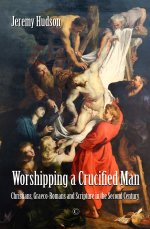Worshipping a Crucified Man: Christians, Graeco-Romans and Scripture in the Second Century
Jeremy Hudson

By the mid-second century Christian writers were engaging in debates with educated audiences from non-Jewish Graeco-Roman cultural backgrounds. A remarkable feature of some of these texts is how extensively they refer to the Jewish scriptures, even though those scriptures were unfamiliar to non-Jewish Graeco-Romans. In Worshipping a Crucified Man, Jeremy Hudson explores for the first time why this should have been so.
As the basis for his argument, Hudson examines three works by Christian converts originally educated in Graeco-Roman traditions: Justin Martyr's First Apology, Tatian's Oratio and Theophilus of Antioch's Ad Autolycum. He considers their literary strategies, their use of quotations and allusions and how they present the Jewish scriptures, all against the background of the Graeco-Roman literary culture familiar to both authors and audiences. The scriptures are presented as a critically defining feature of Christianity, instrumental in shaping the way the new religion presented itself, as it strove to engage with, and challenge, the cultural traditions of the Graeco-Roman world.
Find out more